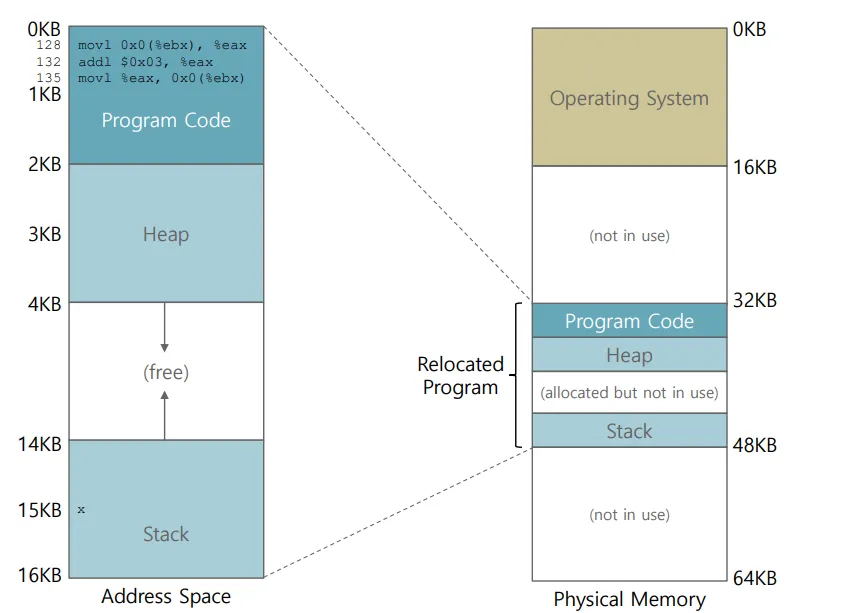Address Translation
프로그램을 짜고 실행하는 코드 내에서는 모두 가상 주소에 접근하도록 되어있으나, 결국에는 데이터를 메모리로부터 가져오기 위해서는 물리 주소가 필요하며 그러한 변환을 운영체제가 관리해준다.
•
Fetch, Load, Store
◦
Fetch : 머신 instruction을 CPU가 가져와 실행하기 위해 Fetch
◦
Load : 실행하는 인스트럭션에 의해 메모리에 있는 데이터를 레지스터로 가져오는 것
◦
Store : 레지스터를 메모리로 다시 저장
Hardware-based Address Translation
Address 번역은 하드웨어가 제공하는 메커닉에 의해 변환된다.
•
CPU마다 Address Translation하는 방법(도구)이 조금씩 차이가 있다.
◦
다만 하드웨어 혼자서는 번역이 안되며 OS가 AT를 위해 하드웨어설정과 자료구조 구축을 잘 해야함.
유연하게 VM을 만드는 방법
•
어플리케이션의 필요에 기반해 어떻게 유연성을 제공할 것인가?
•
메모리 어드레스 스페이스는 어떻게 해당 프로세스만 안전하게 접근하도록 지킬 것인가?
•
메모리를 위한 자료구조를 어떻게 만들 것인가?
Assumptions for Simple Memory Virtualization
1.
한 프로세스를 위한 어드레스 스페이스는 물리적으로 연속된 공간에 존재한다.
2.
한 프로세스를 위한 어드레스 스페이스는 너무 크지 않아야 한다.(피지컬 메모리보다 작음)
3.
모든 프로세스의 어드레스 스페이스는 똑같은 크기를 가진다.
Memory Relocation
Dynamic Relocation
어드레스 스페이스의 슬롯이 응용프로그램이 실행될때마다 위치가 바뀔 수 있음.
•
Base and Bounding
◦
Base 레지스터 : 피지컬 메모리의 시작지점을 알려줌
◦
bounds 레지스터 : 끝 지점
어드레스 변환을 해보자.
•
Physical address = Base + Virtual address(한 어드레스 스페이스 내의 오프셋처럼 취급가능)
128: movl 0x0(%ebx), %eax
PC: 128 -> 32KB(32768B) + 128B = 32896B
x: 15KB -> 32KB + 15KB = 47KB
C
복사
바운드로 프로텍션해보자.
•
접근하려는 메모리 레퍼런스가 바운드보다 클 경우 CPU는 exception을 도출할 것이다.
Hardware Support
Hardware Requirements | Notes |
Privileged mode | Needed to prevent user-mode processes from
executing privileged operations |
base/bounds registers | Need pair of registers per CPU to support
address translation and bounds checks |
Ability to translate virtual addresses
and check if within bounds | Circuitry to do translations and check limits (in
this case, quite simple) |
Privileged instruction(s) to update
base/bounds | OS must be able to set these values before
letting a user program run |
Privileged instruction(s) to register
exception handlers | OS must be able to tell hardware what code to
run if exception occurs |
Ability to raise exceptions | When processes try to access privileged
instructions or out-of-bounds memory |


